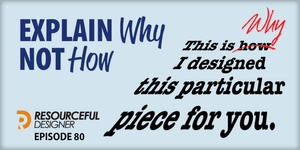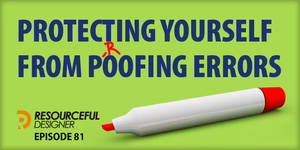
Explain Why, Not How - RD080
07/14/17 • 37 min
If you belong to any graphic design groups on Facebook or Linkedin you've seen people post their work for critique. Why not, it's a great place to get the opinion of fellow designers. However, one problem that happens over and over when people explain their work is they usually explain how they designed it when what they should do is explain why they designed it.
That's the topic I cover in this week's Resourceful Designer podcast. Be sure to listen to the episode for the full story.
Explain why you designed it, not how you designed it.Face it, clients hire you for one reason and one reason only. Your ability to get the job done. They don't care how you get it done. All they care about is the finished product. As long as you can produce good quality work in a timely fashion they will be happy.
Think of a carpenter hired to build a cabinet. The client doesn't care what tools the carpenter uses. Nor does he care what skills or techniques he employs. All the client cares about is having a well crafted and functional cabinet. The same goes for design work. It's the finished product that matters, not the journey you took to get there.
Explain why and avoid going back to the drawing board.Client's don't reside in our world. They don't live and breath design the way we do. Because of this we sometimes forget that clients may not see our designs the same way we do.
If you take the time to enlighten the client and explain why you designed something a certain way, there's a good chance they will appreciate the design much more and you avoid having to go back to the drawing board to change a perfectly good design.
Present in a way that allows you to explain why.Obviously, the best way to present your designs to a client is in person. Unfortunately, it's not always possible to meet face to face with them. Therefore it's up to you to present your designs in a way that allows you to talk to the client as they're seeing the design for the first time.
- Set up a video or phone call and email or provide a link to your design for the client to see while you're talking to them.
- Record a screen capture video explaining your design to the client and send it to them.
However you can manage it, try to be present when your client sees the design for the first time. Explain what they are seeing and explain why you chose to design it that way. Your explanation will go a long way in showing the client the value in the design.
How do you explain your designs to your clients?Let me know by leaving a comment for this episode.
Questions of the WeekSubmit your question to be featured in a future episode of the podcast by visiting the feedback page.
This week’s question comes from Jordan
I was wondering what types of content I can post for my business on social media? I've started creating blog posts. But, I know brands are about 70% content 30% selling when it comes to social media. If you're a potato chip company for example... you can post a picture of your potato chips and say "Have a great summer with acme potato chips". If you're an music entertainment company you can post "It's Miley Cyrus' birthday today. #HappyBirthdayMiley". But, I'm at a loss for what content would be valuable to clients of a graphic design/web developing business and not just targeting other graphic designers, developers, and creatives who aren't my clientele.
To find out what I told Jordan you’ll have to listen to the podcast.
Resource of the week; Four Week Marketing Boost.
I put this guide together in the hopes to encourage you to look at your own brand and image. The daily tasks in my guide require only 15-30 minute of your time and focus on the parts of your marketing material that are often overlooked or neglected. After completing this four-week plan you will be in a better position to present yourself to, and win over new clients.
You can download the Four Week Marketing Boost by visiting marketingboost.net. Or, if you are in the U.S.A. you can text the word MARKETINGBOOST to 44222.
Improve your business' image and create the best first impression possible to attract more clients.
Subscribe to the podcastSubscribe on iTunes Subscribe on Stitcher Subscribe on Android Subscribe on Google Play Music
Contact meSend me ...
If you belong to any graphic design groups on Facebook or Linkedin you've seen people post their work for critique. Why not, it's a great place to get the opinion of fellow designers. However, one problem that happens over and over when people explain their work is they usually explain how they designed it when what they should do is explain why they designed it.
That's the topic I cover in this week's Resourceful Designer podcast. Be sure to listen to the episode for the full story.
Explain why you designed it, not how you designed it.Face it, clients hire you for one reason and one reason only. Your ability to get the job done. They don't care how you get it done. All they care about is the finished product. As long as you can produce good quality work in a timely fashion they will be happy.
Think of a carpenter hired to build a cabinet. The client doesn't care what tools the carpenter uses. Nor does he care what skills or techniques he employs. All the client cares about is having a well crafted and functional cabinet. The same goes for design work. It's the finished product that matters, not the journey you took to get there.
Explain why and avoid going back to the drawing board.Client's don't reside in our world. They don't live and breath design the way we do. Because of this we sometimes forget that clients may not see our designs the same way we do.
If you take the time to enlighten the client and explain why you designed something a certain way, there's a good chance they will appreciate the design much more and you avoid having to go back to the drawing board to change a perfectly good design.
Present in a way that allows you to explain why.Obviously, the best way to present your designs to a client is in person. Unfortunately, it's not always possible to meet face to face with them. Therefore it's up to you to present your designs in a way that allows you to talk to the client as they're seeing the design for the first time.
- Set up a video or phone call and email or provide a link to your design for the client to see while you're talking to them.
- Record a screen capture video explaining your design to the client and send it to them.
However you can manage it, try to be present when your client sees the design for the first time. Explain what they are seeing and explain why you chose to design it that way. Your explanation will go a long way in showing the client the value in the design.
How do you explain your designs to your clients?Let me know by leaving a comment for this episode.
Questions of the WeekSubmit your question to be featured in a future episode of the podcast by visiting the feedback page.
This week’s question comes from Jordan
I was wondering what types of content I can post for my business on social media? I've started creating blog posts. But, I know brands are about 70% content 30% selling when it comes to social media. If you're a potato chip company for example... you can post a picture of your potato chips and say "Have a great summer with acme potato chips". If you're an music entertainment company you can post "It's Miley Cyrus' birthday today. #HappyBirthdayMiley". But, I'm at a loss for what content would be valuable to clients of a graphic design/web developing business and not just targeting other graphic designers, developers, and creatives who aren't my clientele.
To find out what I told Jordan you’ll have to listen to the podcast.
Resource of the week; Four Week Marketing Boost.
I put this guide together in the hopes to encourage you to look at your own brand and image. The daily tasks in my guide require only 15-30 minute of your time and focus on the parts of your marketing material that are often overlooked or neglected. After completing this four-week plan you will be in a better position to present yourself to, and win over new clients.
You can download the Four Week Marketing Boost by visiting marketingboost.net. Or, if you are in the U.S.A. you can text the word MARKETINGBOOST to 44222.
Improve your business' image and create the best first impression possible to attract more clients.
Subscribe to the podcastSubscribe on iTunes Subscribe on Stitcher Subscribe on Android Subscribe on Google Play Music
Contact meSend me ...
Previous Episode

Word Of Mouth Referrals For Your Design Business - RD079
Do you get word of mouth referrals for your design business?
Growing your design business takes a lot of hard work. Especially when first starting out. Word of mouth referrals are and always will be the most effective way of achieving this growth.
Back in episode 67 of the podcast, I shared a proven strategy for getting design referrals. That episode was more geared to designers working in a specific niche. I received a lot of great feedback on that episode but one question kept coming up. How do I get design referrals if I don't have a niche? Hence this episode, be sure to listen to the podcast for all the details.
As designers, we work in a world of marketing, advertising, promoting, social sharing and so much more, but nothing beats an evangelist who spreads the word about you and your services by word of mouth.
When you break it down to its core elements, there are only two main ingredients to garner word of mouth referrals.
- You need to offer great designs to your clients
- You need to offer great service to your clients
That's it. If you can offer both of those you are on your way to getting word of mouth referrals.
It all comes down to client relationships. The better the relationship with your client the better the chance they will refer someone to you.
Why is word of mouth so important?Here are some stats I came across while researching this episode.
92% of consumers are influenced by word of mouth.This means 92% of potential clients will choose a designer based on what they are told over what they see or read in advertising.
76% of consumers refer a company they trust.This means 76% of your clients will refer you to someone else providing they have a good relationship with you.
59% of business will ask their peers for advice before making a purchaseThis means 59% of business owners, your potential clients, will ask other business owners their advice before choosing a designer.
With these numbers already in your favour, why not give them a little push. Don't sit back and wait to see what will happen. Be proactive and take charge of your own word of mouth campaign.
How you should promote word of mouth referrals Be proactive.Don’t wait until after the project is done to ask for referrals. Ask for referrals up front. Tell your clients from the start what services you will be providing them and ask that they share what you’re doing with others. Tell them that if they’re happy working with you, you would be grateful if they would pass on your name to friends, family and colleagues who might require similar work.
Be sure to mention other services you do that they could refer you for. Who knows, you may even get more work from them.
Offer an expiring incentive for referrals.Even with the best of intentions clients will probably forget to refer you when the chance arises. But if you offer them an incentive, especially one with an expiry date, they will be more inclined to think about who could use your services.
Offering a gift card for every referral they send your way is nice. However, offering a gift card for every referral they send your way within the next 30 days gives them a lot more incentive to talk about you.
Give them an easy way to make referrals.The easier you make it for them the more chance they will refer you. Give them extra business cards to hand out. Provide them with your social media profiles to share. Create a referral form on your website they can use to introduce potential clients to you.
Thank them and keep on thanking them.As soon as you hear from a referred client, even if they don't hire you, you should thank the person that referred them to you. Letting your client know how much you appreciate the referral will go a long way to garner even more referrals.
If the referred client does hire you, let the client that referred them know how the project turned out. You can even send them a thank you gift afterwards regardless if you gave them a referral incentive or not. The bigger the project the more personal the thank you should be.
It's all up to you.By taking advantage of these simple tools you will become more visible, gain the trust of your clients, build better relationships with them, and increase your bottom line.
Start your word of mouth campaign today!
How have you promoted word of mouth referrals for your design business?Let me know by leaving a comment for this episode.
Questions of the WeekSubmit your question to be featured in a future episode of the podcast by visiting the
Next Episode

Protecting Yourself From Proofing Errors - RD081
Have you ever been burned due to proofing errors?
Proofing errors are the bane of all graphic designers. Anyone who has been in this business long enough knows that clients will almost always try to blame you when they find errors on their project.
You can’t really blame them, it’s human instinct to try and pass the blame. We’ve been doing it since we were young. Even a toddler who sneaks a cookie might try to blame it on one of his siblings or maybe even on the family dog.
It’s because of this instinct that we need to protect ourselves. Because when it comes to proofing errors on graphic design jobs, especially when printing is involved, there’s a lot more at stake than a simple reprimand for eating a cookie.
It’s not as big a deal when it’s a website or some other digital piece. Those errors can easily be fixed. But fixing an error on a printed job could cost thousands if not hundreds of thousands of dollars. And you don’t want that on you.
On this episode of the Resourceful Designer podcast, I discuss ways to protect yourself from proofing errors. Be sure to listen to the episode for the full story.
How do you protect yourself from proofing errors?You can't. Proofing errors are going to happen. It’s the blame you need to protect yourself from and it all starts with your contract.
Your contract may be full of unintelligible legalese but all that bloated wording is there for a reason, to protect you. On your contract, you must include a clause absolving you of any blame once the client approves and signs off on a job. Once they sign off, it’s in their hands and you are clear of any blame.
For this reason, you should NEVER ACCEPT an approval from your client that says something like “we approve this job with this one small change”. No matter how trivial the change is, you need to have it viewed and approved by the client.
You may think to yourself "that paragraph that's missing a period at the end isn’t a big deal. I’ll just add the period and send the file to print."
Don’t do it.
Every time you touch a project there’s a possibility of something going wrong, something shifting, something changing. So don’t take any chances. Get the client to approve every change they ask for. Even if it means delaying a deadline to get that approval.
Here's an example of how a simple revision could go wrong.A client tells you the job is approved once you change "S. Thompson" to "Steve Thompson" on page 3. You go to page 3, find "S. Thompson" and charge it, as requested to "Steve Thompson" and send the job to print.
But unknown to you, "S. Thompson" appears 2 times on the third page. The client wasn't specific and you didn't realize there were multiple occurrences and only changed the first one.
What started out as a simple change turns into a costly error that could have been avoided if only the client had seen the revision before it went to print.
Regarding your contract.Your contract should state that the client is fully responsible for making sure every aspect of the job is satisfactory to their liking. This includes layout, text, copy, images, colours, folding, etc.
Your contract should also state that the client is ultimately responsible for any errors, EVEN IF THE COPY THEY SUPPLIED YOU WAS CORRECT.
This is a very important one. Clients will often proofread their copy before providing it to you and think they don't have to proofread it afterwards. You need to make sure the client still proofreads it to make sure nothing has changed between the time they supplied it and the time they approve it.
Remind your client that you are not responsible for any errors should the client not proof the job carefully.
Beyond the contractEven with a clause in your contract absolving you of any errors due to improper proofing, you should take it upon yourself to remind the client with every proof you supply them. A simple statement told to them or a small paragraph in an email stating once again that you are not responsible for any errors or omissions once they sign off on the job.
The more you remind them, the less chance they come after you should an error be found afterwards.
Things that could help prevent errors.Don't forget to use your computer's Spell Check/Grammar Check features. It's such an easy thing to forget to do but it could save you many headaches down the road.
Proofread your work. You are not responsible for spelling errors but they still look bad on a piece you designed. Read everything yourself to see if you can spot any problems. Tip, read from right to left, one word at a time. This will force you to read each word individually and you’ll catch more spelling errors that way.
The mind is a wonderful but weird tool. You can easily overlook misspelt words that are right in front of you as you are reading. Have you ever seen this paragraph before...
If you like this episode you’ll love

Resourceful Designer: Strategies for running a graphic design business

Joomla Beat Podcast | Web design, development, online marketing, social media & website management

Entrepreneurs on Fire

Shailey & Katie's Lemonade Stand: Design Moms Finding the Happy Balance as Work-from-home Entrepreneurs

The Portrait System Podcast
Episode Comments
Generate a badge
Get a badge for your website that links back to this episode
<a href="https://goodpods.com/podcasts/resourceful-designer-strategies-for-running-a-graphic-design-business-1053/explain-why-not-how-rd080-7198529"> <img src="https://storage.googleapis.com/goodpods-images-bucket/badges/generic-badge-1.svg" alt="listen to explain why, not how - rd080 on goodpods" style="width: 225px" /> </a>
Copy